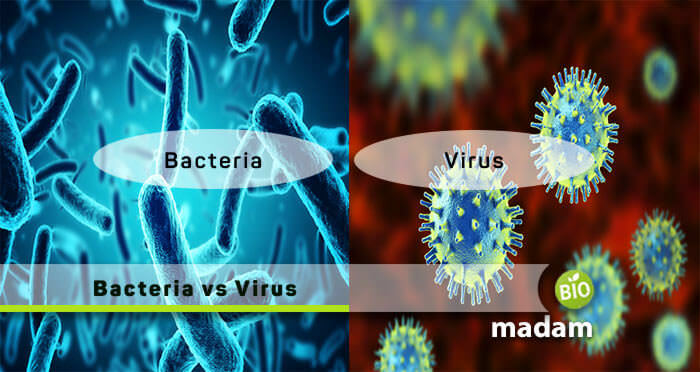Today it’s a great opportunity to elaborate you the difference between bacteria and viruses. We will discuss the helpful information regarding these two microorganisms with you. So let’s get started!
Bacteria are naturally occurring microbes present everywhere around you. Most of these are beneficial, and just 1% of them are harmful to human beings. People weren’t aware enough to fight harmful bacteria in the past, but today, many efficient antibiotics are discovered to kill such microbes.
On the other hand, Viruses are pathogens that depend on a living host to survive. A virus always covers its course before eliminating it from a body, or in an otherwise cases, the body’s immune should be that strong to surpass them. Humans are more prone to getting infected with viruses, such as influenza or a common cold. We’ll begin by comparing the two entities through a comparison chart.
Comparison Table
| Parameters | Bacteria | Virus |
| Living Attributes | Living | Non-Living |
| Ribosomes | Present | Absent |
| Size of Microbe | 1000 nm | 20-400 nm |
| Cellular Nature | Unicellular | Lack Cells |
| Cell Wall | Peptidoglycan | No Cell Wall |
| Genetic Material | Circular Chromosome or Dispersed Chromatin | DNA/RNA Strand |
| Type of Infection | Localized | Systemic |
| Reproduction | Can Reproduce By Itself | Requires a Host to Reproduce |
| Diseases | Meningitis, Encephalitis, Gastritis, etc. | Influenza, AIDS, etc. |
| Examples | Vibrio cholerae, Bacillus | Hepatitis A, HIV, measles |
Bacteria – Brief Description
Bacteria are known to be prokaryotic (don’t have a distinct nucleus), and unicellular entities. These microorganisms are globally present, ranging from the hottest temperatures to the coldest environments, inside your body or in the surroundings, and so on. In other words, bacteria exist everywhere in the open air, oceans, deep earth, or inside a living body. It’s quite easy to differentiate a bacterium from eukaryotic cells because of its single-cell nature. Maximum bacteria are beneficial to human beings, like probiotics, and a minimum of them are destructive, thus treated by giving specific antibiotics.

Scientists have further categorized bacteria based on their shapes. These are:
Cocci – are round or spherical-shaped bacteria.
Spirilla – are spiral in shape bacteria.
Bacillus – are known to be rod-shaped.
Vibrio – are bacteria with a comma shape.
Most bacteria are seen living as single-celled organisms, but a few live in pairs, called diploids. Moreover, they’re grouped as Streptococcus and Staphylococcus. The former occurs in chains, while the latter creates a bunch/cluster.
Virus – Brief Description
Viruses are neither prokaryotes nor eukaryotes, but they draw a line between living and non-living. The study of viruses is called “Virology.” Coming from a Latin term, virus means a “slimy liquid” or simply a “poison.” Viruses are dangerous infectious entities that cannot be seen with the naked eye. Microbiologists utilize a compound microscope to observe a virus. They are deprived of a distinct cellular structure but consist of a protein-coated genetic material. Viruses are spread everywhere and have even more diversity than plants and animals.

These microorganisms are classified into seven groups based on their nature of producing mRNA. Scientists called this classification the Baltimore classification. Accordingly, these are identified as:
- dsDNA viruses
- dsRNA viruses
- ssDNA viruses
- (+)ssRNA viruses
- (-)ssRNA viruses
- ssRNA-RT viruses
- dsDNA-Rt viruses
Other than these, viruses also have morphology-based classification. These are grouped into filamentous, spherical, or complex viruses. These parasitic structures rapidly reproduce when residing in a host organism. Furthermore, many viruses have RNA as a genomic material, e.g., plant viruses.
Similarities between Bacteria & Virus
Despite being dissimilar, these microorganisms do have some similarities that are mentioned below:
- These bacteria and viruses fall under the class of microorganisms invisible to the naked eye.
- Both can be seen under an electron microscope, whether it’s a bacterium or a virus.
- Both microorganisms do not have a distinct nucleus in them.
- Both of them can infect a person in one or another, so they come under disease-causing agents.
Differences between Bacteria & Virus
Size of Microorganism
Bacteria
The actual size of bacteria is approximately 1000 nm, observed under an electron microscope.
Virus
On the other hand, these microbes range from 20 nm – to 400 nm, depending on the virus type.
Cell Wall
Bacteria
The prokaryotes, like bacteria, have cell walls made up of peptidoglycan or lipopolysaccharide.
Virus
Conversely, viruses do not possess a cell wall. In fact, they have got a protein coat helping them replicate.
Mode of Classification
Bacteria
One can classify a bacterium in several ways: size, shape, mode of nutrition, gram-negative membrane, gram-positive membrane, etc.
Virus
These infectious agents, in contrast, are broadly classified based on their genetic material, which is either DNA or RNA.
Method of Reproduction
Bacteria
These microorganisms can replicate asexually via the binary fission and fragmentation methods.
Virus
Conversely, viruses attack a living host and penetrate to replicate its genetic material (DNA/RNA). This way, a host cell is forced to make multiple copies of a virus, and so it grows.
Duration of Infection
Bacteria
A bacterial infection usually stays for 8-10 days, leading to a high fever. Common bacterial infections include gastritis, leprosy, tuberculosis, ulcer, pneumonia, etc.
Virus
On the contrary, a viral infection normally remains for 2-10 days, in influenza, chickenpox, AIDS, common cold, etc.
Types of Microorganisms
Bacteria
The common bacteria are Vibrio cholerae, Bacillus, Streptococcus, Spirillum, etc.
Virus
The well-known viruses include Hepatitis A, T4 bacteriophage, Papillomavirus, Antiherpes virus, etc.
Beneficial or Harmful

Bacteria
These microorganisms can either be beneficial or harmful. The human body is home to almost a hundred trillion good bacteria.
Virus
On the other side, viruses are most of the time harmful, causing different diseases and infections. The only viral benefit seen is in genetic engineering.
Treatment
Bacteria
Antibiotics help treat bacterial infections, but can cause constipation while treating the infections.
Virus
In contrast, vaccination is done to help avoid spreading the virus.
Conclusion
As in the above article, we finally understood the differences between bacteria and viruses, so one should always take precautionary measures to treat these microbial agents. Despite most bacteria being advantageous for human beings, many cause diseases. Similarly, all viruses are pathogenic organisms that will harm one body somehow or the other. So, get the appropriate treatment if these microbes catch you.

Hello, I would like to introduce myself to you! I am Chelsea Rogers, an experienced blog writer for science articles, holding an MPhil degree. My enthusiasm to grab the best knowledge, let it relate to botany, zoology, or any other science branch. Read my articles & let me wait for your words s in the comment section.

